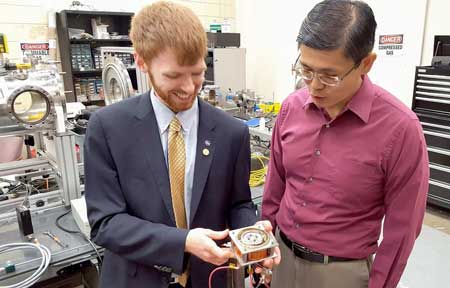| Dec 01, 2017 |
3D-printing a Hall-effect thruster
|
|
(Nanowerk News) Ethan Hopping has always been passionate about space. “I remember visiting the U.S. Space & Rocket Center in elementary school,” he says, “and being inspired by the story of the Apollo program and Huntsville’s role in it.”
|
|
That inspiration initially led him to earn his undergraduate degree in aerospace engineering at The University of Alabama in Huntsville (UAH) in 2015, and to return to UAH to pursue his master’s degree in aerospace systems engineering after a summer internship with NASA’s Marshall Space Flight Center. Now Hopping is set to graduate after completing an ambitious Hall-effect thruster research project under the guidance of Dr. Gabe Xu, an assistant professor in the Department of Mechanical and Aerospace Engineering.
|
 |
| Ethan Hopping, who now works at Blue Origin, and UAH professor Dr. Gabe Xu partnered to design and test a Hall-effect thruster with a 3-D printed channel and propellant distributor.
|
|
Like chemical rockets that push payloads into orbit, Hall-effect thrusters – named for American physicist Edwin Hall – are used for the same purpose but with much higher efficiency and lower force. That’s because, while the former store the energy necessary for producing thrust in the propellant’s chemical bonds, Hall-effect thrusters use plasma and electric fields to accelerate the atoms to very high speeds of multiple kilometers per second.
|
|
Depending on the mission, electric propulsion systems like Hall-effect-thrusters can reduce the mass of propellant required by a factor of 10 or more as compared with chemical rockets. Consequently, they have the ability to reach deep-space destinations that are currently inaccessible to their chemical counterparts.
|
|
“I humorously like to say that ion engines and Hall-effect thrusters are the Prius of the in-space propulsion world,” says Hopping, “because they rely on high fuel efficiency to bring about significant cost reduction and range improvements, but at the expense of high thrust.”
|
|
The project emerged from Dr. Xu’s interest in the effect of different geometric parameters on the performance of miniature Hall-effect thrusters. There was one problem, however; to test these different effects would require multiple thruster prototypes, each with varying dimensions, and that would quickly get expensive. “The high cost of manufacturing not only limits research opportunities, but also limits the use of Hall-effect thrusters in small satellites because the propulsion systems are too expensive in comparison with the rest of the satellite,” explains Hopping.
|
|
The solution turned out to be the low cost and fast turnaround of 3-D printing. Hopping, who already had experience with 3-D printing, was tasked with designing and building a fully functioning miniature Hall-effect thruster from scratch. His product, the UAH-78AM, is the first Hall-effect thruster to be built at UAH.
|
|
“We scaled our design from a larger Hall-effect thruster that had publicly available design and performance data,” explains Dr. Xu. Hopping then worked on the magnetic field design, a feat that included learning three different modeling programs. Ten months later, Hopping and Dr. Xu tested the first version of the thruster in the small vacuum chamber at UAH’s Johnson Research Center and it worked.
|
|
After some design modifications, Hopping took the thruster to NASA’s Glenn Research Center in Cleveland, Ohio, to collect performance measurements. Those ultimately proved that the UAH-78AM, though composed of 3-D printed parts, worked just as well as traditional thrusters of the same size and power level, but at a fraction of the cost and production time. “This was an amazing opportunity,” Hopping recalls, “to be surrounded by electric propulsion system experts and work in a research environment that has a long history of developing and testing Hall-effect thrusters. I learned a lot!”
|
|
Hopping and Dr. Xu presented a paper ("Design and Testing of a Hall Effect Thruster with 3D Printed Channel and Propellant Distributor") on their project this past October at the International Electric Propulsion Conference in Atlanta, Ga. And while Hopping is now looking forward to next month’s graduation, he’s already putting to use what he learned at UAH as a propulsion development engineer at Blue Origin in Kent, Wash.
|
|
“My time at UAH equipped me with the knowledge and experience I need to support Blue Origin’s mission as an aerospace engineer,” he says. “I didn’t know exactly what I wanted to do professionally when I started school, but I was sure that I wanted to support an industry that challenges us to be better, both as individuals and as a species, and spaceflight certainly does that!”
|

